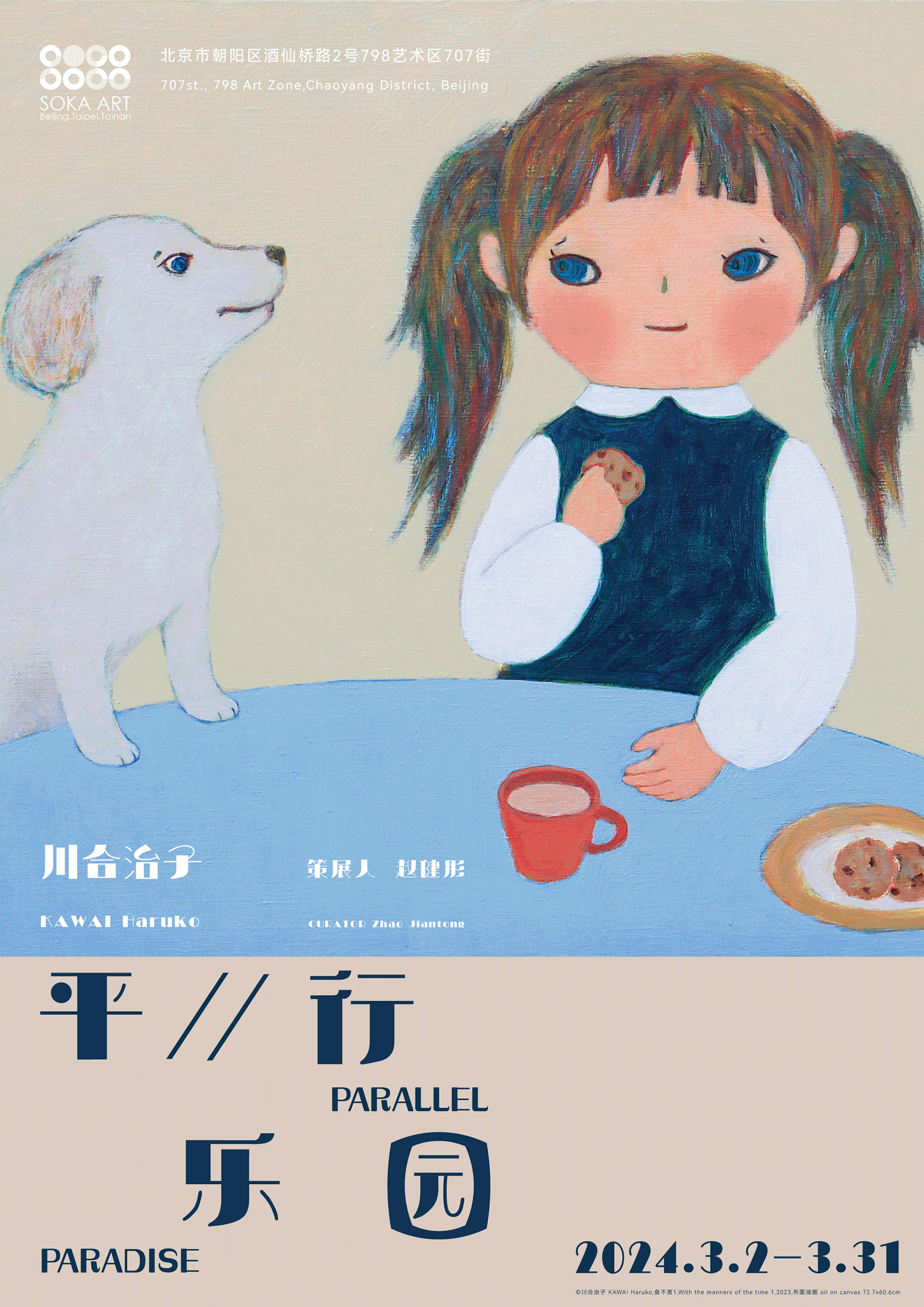展期 Period:
2024.3.2—2024.3.31
艺术家 Artist:
饭田桐子 Iida Kiriko、川合治子 Kawai Haruko
策展人 Curator:
地点 Venue:
索卡艺术 Soka Art(北京)
新闻稿 Press Release:
索卡艺术荣幸宣布饭田桐子和川合治子的双个展《平行乐园》将于2024年3月2日在索卡艺术(北京)开幕,并持续展出至2024年3月31日。本次展览将集中展示两位艺术家近十年的创作,天真烂漫的创作语言和童年记忆中保鲜的好天气,带人们回顾最初的美好。
平行乐园是艺术家隐藏在图像之下抛弃现实世界规则的心灵栖息地。如果说绘画的过程是艺术家的桃花源,画中的世界即是观者进入理想国的入口,遵循的规则是童年记忆中最甜美的部分以及客观事实之上的纯粹幻想。
1970年出生北海道的饭田桐子,毕业于北海道设计学院。饭田作品中所流露的场域也如同她的家乡般静谧纯洁。从江户时代的“虾夷地”到明治年间改名为北海道,长期居住在这片广袤土地上的原住民阿伊努人信仰“万物有灵”(Animistic Faith),他们还相信世界是由无数的浮世交叠而成,每个梦境都是人在另一个浮世的片断,万物的消逝与滋长都蕴藏在其中。
饭田的作品像是无意间被撞见的一个秘密,具有真实性又被刻意隐藏的奇幻世界。画面中无邪的脸庞凝视着画面之外,睫毛尖同时闪着忧伤和希望,打破与观者之间的“第四面墙”。少年捉摸不透的微妙情感内敛克制,带有隐微阴翳相伴的寂静。饭田作品中提示的幽玄之美如苏联诗人鲍里斯·帕斯捷尔纳克在《初寒》中所建造的氛围那样幽深玄妙,“而星星暗自揣测,在边远别墅的冬天里,究竟有什么奇幻之事,如同它在天上所见”
1968年出生于名古屋的川合治子,毕业于爱知县立艺术大学的美术系,并一直居住在名古屋的乡下村庄。她的创作语汇一直饱含着生命体验最初的好奇和探索,对世界的初次认知。彩色拼接的旷野,棉花糖味道的云,橘子皮材质的山是人们对童真理解的幻想共识,川合通过建立一个真空且隔绝现实污染的乌托邦使人们反思现代社会中弱势群体所遭受的苦难与战争以及对人类对大自然的勒索与破坏。川合希望用生命最初的美好经验唤醒人们的同情与敬畏之心。其供应的柔软画面正如马蒂斯的“安乐椅理论”,艺术就像一把舒适的安乐椅,对心灵起着一种抚慰的作用。川合始终保持童趣的方法是与大自然接触,乐此不疲得用五种感官享受每天不一样的风景和自然中的信息,比如品尝春天发芽的野菜。她的作品像是儿童时代视若珍宝百读不厌的故事书,或是第一次拿起蜡笔画出的自画像。川合希望人们能记住这种感觉,虽然不完美但却是尝试构筑一切美好的起点。顺着田野上的小路回到了无忧嬉戏的午后,找到一个完美的捉迷藏地点,既满足又兴奋,青草和阳光的混合物弥漫着填满思绪的间隙。川合帮我们实现了重回童年发光午后的幻想。
每个人都有着属于自己的意识空间,当人们面对作品呈现的一个名词时,就会不自觉沿着这个词走进艺术家的意识空间,即使个体的意识空间无论是混沌的,盲从的,模糊不确定的,但在每个独立意识中会对作者呈现的符号重构产生自己的诠释。《平行乐园》就像是法国作家安托万·德·圣-埃克苏佩里的《小王子》,孩童和大人都可以阅读,感受却不相同,仿佛一面镜子,不同的人映出不同的影像。
Soka Art is pleased to announce that the duo exhibition Parallel Paradise by artists IIDA Kiriko and KAWAI Haruko will be held on March 2, 2024 to March 31, 2024 at Soka Art Beijing. The exhibition will present almost forty works created by both artists in past ten years, the naive creative language in the images and the good weather preserved in childhood memories take the audience back to the initial pure beauty of life.
Parallel Paradise is the artist's spiritual habitat hidden under the picture by abandoning the rules of the real world. If the process of painting is the artist's utopia, the world in the painting is the viewer's entrance to the ideal country, following the sweetest part of childhood memories, the pure fantasy that exists above the objective facts.
IIDA Kiriko was born in Hokkaido in 1970, and graduated from Hokkaido Institute of Design. The field of IIDA's works is as serene and pure as her hometown. From the Edo period when it was known as "Ezo Land" to the Meiji period when it was renamed Hokkaido, the Ainu people, who have long inhabited this vast land, believe in the Animistic Faith, and that the world is made up of a myriad of floating worlds, each of which is a fragment of another floating world in which everything passes and grows. They also believe that the world is made up of a myriad of floating worlds, and that each dream is a fragment of a person's experience in another floating world, in which everything passes away and grows. IIDA's works are like a secret discovered by accident, a fantasy world that is real but deliberately hidden. The innocent face staring out of the frame, the tips of its eyelashes flickering simultaneously with sadness and hope, breaks the "fourth wall" between it and the viewer. The elusive subtlety of the young man's emotions is restrained, the with a silence that is accompanied by a faint shade of cloudiness. IIDA's work suggests an esoteric beauty as profound as the atmosphere created by Soviet poet Boris Pasternak in Initial Cold, “And the stars secretly speculate what wondrous things are done in the winter at the remote villa, as it is seen in the heavens.”
KAWAI Haruko was born in Nagoya in 1968, and graduated from Aichi Prefectural University of Fine Arts and Music, now she works and lives in Nagoya. The content of her creations is always saturated with the initial curiosity and exploration of life experience and the initial perception of the world. Colorful wilderness, cotton candy-flavored clouds, and mountains made of orange peels are the fantasy consensus of people's childhood innocence. By establishing a vacuum and a utopia isolated from the reality of pollution, KAWAI makes individuals reflect on the suffering of the disadvantaged groups in the modern society, wars, and the damage of human beings to nature. She hopes to use the initial beautiful experience of life to evoke sympathy and reverence. The soft images she offers are similar to Matisse's "comfort chair theory," which states that art is like a comfortable comfort chair that soothes the soul. KAWAI's way of maintaining her childishness is to be in touch with nature, enjoying the different landscapes and messages from nature with all five senses, such as tasting the wild vegetables sprouting in spring. Her work is like a storybook that people treasured as children and never got tired of reading, or a self-portrait of the first time they picked up a crayon and drew a picture. KAWAI hopes that people will remember this feeling, imperfect as it is, as the starting point for trying to build something beautiful. Following a path through a field back to a carefree afternoon of play, finding the perfect hide-and-seek spot is both satisfying and exciting, and the mixture of grass and sunshine fills the gaps in our thoughts. KAWAI helped us realize the fantasy of returning to the glowing afternoons of our childhood.
Everyone has his or her own space of consciousness, and when individuals are confronted with a term presented in a work, they will unconsciously walk along the term into the artist's space of consciousness, and even though the individual's space of consciousness may be chaotic, blindly obedient, and vaguely indeterminate, each individual consciousness will produce their own interpretation of the author's presentation of the symbolic reconstruction. Parallel Paradise is like French writer Antoine de Saint-Exupéry's The Little Prince, which can be read by children and adults alike with different feelings, as if it were a mirror reflecting different images to different people.

